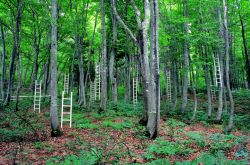Echigo-Tsumari and Australia
Australia has been participating in the Echigo-Tsumari Art Triennale (ETAT) since its beginning in 2000 and has established a close relationship with the Echigo-Tsumari region.
The first reason lies in the theme of the ETAT that "human beings are a part of nature" – a concept that many Australians can relate to. The scenery of the mountainous Echigo-Tsumari region, which experiences some of the heaviest snowfalls in winter and is rich green in summer, is vastly different to that of Australia, where over two-thirds of the land surface is covered by desert. However, the Echigo-Tsumari way of living, where people learned to coexist with the harsh natural environment by passing on customs and traditions from generation to generation, is similar to that of Australia where Indigenous people have been living for more than 40,000 years.
As a result of this long-standing relationship between Australia and Echigo-Tsumari, the original Australia House was built in 2009. Since then, Australia and Echigo-Tsumari have deepened this relationship through annual Artist-in-Residence Programs and a student exchange project.
The original Australia House collapsed in an earthquake centred on neighbouring Nagano Prefecture on 12 March 2011. However, with the assistance of the Tokamachi City Government the Australia-Japan Foundation, architects, artists, volunteers and supporters, Australia House will be rebuilt in time for the 2012 ETAT. The new Australia House will stand as a symbol of Australia's support for Japan's recovery and develop its role as a base for Australia-Japan cultural exchange.
Messages from supporters of Australia House Project
The Participation of Australia in the Echigo-Tsumari Art Field
2000 (The First ETAT)

- Fiona Foley "Dharma Eye"
- Anne Graham
- Hossein Valamanesh "In Memory of Snow"
2003 (The Second ETAT)
- Anne Graham "Snake Path"
- Nigel Helyer "Everything is Nice with American Rice"
- Janet Laurence "Elixir" Permanent Installation
- Lauren Berkowitz "Harvest House" Permanent Installation
- Robyn Backen "Rice Talk" Permanent Installation
- "Spirit Country: Contemporary Australian Aboriginal Art" Exhibited at Echigo-Matsunoyama Museum of Natural Science
- Sally Couacaud, an independent art curator participated as a Short Video Festival Jury
- Dawn Casey, director of the National Museum of Australia (at that time) participated as a panellist in the Global Environmental Seminar
- Anthony Bond, Assistant Director, Art Gallery of New South Wales participated in the Echigo-Tsumari Art Symposium
2006 (The Third ETAT)
More about the Australian artists in 2006
- Anne Graham "Fishing House"
- Dadang Christanto "Cakra Kul-Kul at Tsumari"
- Sue Pedley "HAZE"
- Ben Morieson "Burnout 2006-Radio Controlled in Echigo-Tsumari"
- Andrea Kleist, Public Art Program Manager for the City of Melbourne participated as coordinator
2009 (The Fourth ETAT)
More about the Australian artists in 2009
- Lucy Bleach "Oral Fibre"
- Alex Rizkalla "Japan Kunstkammer"
- Richard Thomas "OIKOS"
- Cass Matthews participated as coordinator
- Anthony Bond, Assistant Director, Art Gallery of New South Wales contributed as Art Advisor of the Triennale
- Australia House Started
2009 Australia House News Archives
2009 Australia House Photo Archives
2009 Australia House Diary Archives
2010
- Artist-in-Residency Program
- Japan Australia Art Musings Project
2010 Australia House News Archives
2010 Australia House Photo Archives
2010 Australia House Diary Archives
2011
About the Australian artist in 2011
- Echigo-Tsumari Artist-in-Residence Program
2011 Australia House News Archives
2010 Australia House Diary Archives

